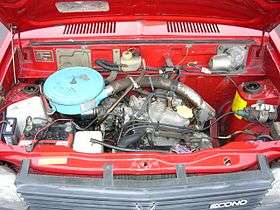Mitsubishi Vulcan engine
| 2G2 | |
|---|---|
 | |
| Overview | |
| Manufacturer | Mitsubishi Motors |
| Also called | Vulcan |
| Production | 1972–1989 |
| Chronology | |
| Predecessor | Mitsubishi 2G1 engine |
| Successor | Mitsubishi 3G8 engine |
The Mitsubishi Vulcan engine, identified by the code 2G2, is an iron-block twin cylinder engine with three main bearings, built by Mitsubishi Motors for kei car class vehicles from September 1972. It was an overhead camshaft design, and superseded the older two-stroke 2G1 series. The 2G2 was in turn replaced by the Multi-valve 3G8 three-cylinder series.
2G21
Specifications
| Engine type | Twin cylinder OHC |
| Displacement | 359 cc |
| Bore x stroke | 62.0 x 59.6 mm |
| Fuel type | Regular gasoline |
| Peak power | 22 kW (30 PS) at 6,000 rpm (Minica F4, Minicab 4)
"Vulcan S", December 1974 on, with "Silent Shaft" balance shafts. (MCA-II) |
| 24 kW (32 PS) at 8,000 rpm (Minica F4)
First version, without balance shafts. (MCA) | |
| 26 kW (36 PS) at 8,500 rpm (Minica F4 GS, GSL, Minica Skipper IV)
"Sports Series" with twin carbs. The F4 sports series was discontinued in October 1973. | |
| Peak torque | ?? N·m (?? lb·ft) at ??00 rpm (MCA-II) |
| 3.0 kg·m (29.4 N·m) at 5,500 rpm (MCA) | |
| 3.2 kg·m (31.4 N·m) at 6,500 rpm (twin-carb sports) |
"MCA" stood for "Mitsubishi Clean Air", reflecting Japan's new air quality laws. The MCA-II was cleaner yet, and with balance shafts it also offered a much smoother run, at the loss of a few horsepower. The Sports engine did not meet the stricter emissions laws, which led to the demise of the Skipper.
Applications
- 10.1972-04.1976 Mitsubishi Minica F4
- 10.1972-12.1974 Mitsubishi Minica Skipper IV
2G22
Specifications
| Engine type | Twin cylinder SOHC |
| Displacement | 471 cc |
| Bore x stroke | 65.0 x 71.0 mm |
| Fuel type | Regular gasoline, 9.0:1 compression |
| Peak power | 21 kW (28 PS) at 6000 rpm: Minica 5 Van, Minicab 5
22 kW (30 PS) at 6500 rpm: Minica 5 Sedan |
| Peak torque | 3.7 kg·m (36.3 N·m) at 4000 rpm (all)[1] |
This engine met the enlarged kei-jidosha regulations which took effect in 1975. It was called the Vulcan S in period advertising. It had been thought that the rules would only allow for 500 cc, so a number of manufacturers had to quickly develop 550 cc models. The 2G22 was only built for ten months.
Applications
- 1976.05-1977.06 Mitsubishi Minica 5
- 1976.05-1977.03 Mitsubishi Minica 5 Van
- 1976.04-1977.03 Mitsubishi Minicab 5 (truck)
2G23
The G23B engines also featured the MCA-JET improved emissions system with a catalytic converter and three valves per cylinder. For the last two years (until summer of 1989), production was only for the Mazda Porter.
Specifications
| Engine type | Twin cylinder SOHC |
| Displacement | 546 cc |
| Bore x stroke | 70.0 x 71.0 mm |
| Fuel type | Regular gasoline |
| Peak power | 22 kW (29 PS) at 5500 rpm (2G23) Minicab 55 Wide/Minica 55 Van/Econo only (with catalytic converter), Mazda Porter Cab
23 kW (31 PS) at 5500 rpm (2G23) Minica, Minicab after 1979 |
| 23 kW (31 PS) at 5500 rpm (G23B Vulcan II with timing chain)
23 kW (31 PS) at 6000 rpm (G23B Vulcan II with timing belt), 84-87 Minica Econo, Minicab 24 kW (33 PS) at 6000 rpm (G23B Vulcan II with timing belt), 84-87 Minica | |
| 29 kW (39 PS) at 5500 rpm (G23B Turbo), Minica Ami/Econo 03.83-02.84
31 kW (42 PS) at 6000 rpm (G23B Turbo Intercooler) | |
| Peak torque | 4.1 kg·m (40.2 N·m) at 3000 rpm (2G23)
4.2 kg·m (41.2 N·m) at 3000 rpm (2G23) in Minica 55 Van, Minicab 55 Wide until 1979 |
| 4.2 kg·m (41.2 N·m) at 3500 rpm (G23B)
43 (or 44) Nm at 3500 rpm (84-87) | |
| 54 Nm at 3500 rpm (G23B Turbo)
57 Nm at 3500 rpm (G23B Turbo Intercooler) | |
Applications
- 1977-1979 Mitsubishi Minicab Wide 55 (LO13)
- 1979-1987 Mitsubishi Minicab (truck)
- 03.1977-09.1981 Minica 55 Van[2]
- 06.1977-02.1984 Mitsubishi Minica Ami 55/Ami L/Econo
- 02.1984-01.1987 Mitsubishi Minica/Econo 5th generation
- 1977-1980 Mitsubishi L100
- 1977-83 Mazda New Porter Cab (2G23)
- 1983-07.1989 Mazda Porter Cab (G23B)
2G24
Specifications
| Engine type | Twin cylinder SOHC |
| Displacement | 644 cc |
| Bore x stroke | 76.0 x 71.0 mm |
| Fuel type | Regular gasoline |
| Peak power | ? |
| Peak torque | ? |
Produced 8.82-12.83
Applications
- 1983 Mitsubishi Minicab 700 (truck)
- 1985-1990s Liuzhou Wuling LZ110
2G25
Specifications
| Engine type | Twin cylinder SOHC |
| Displacement | 783 cc |
| Bore x stroke | 78.0 x 72.0 mm (according to various sources, although this would make it 688 cc) |
| Fuel type | Regular gasoline |
| Peak power | ? |
| Peak torque | ? |
Produced 1.84-11.88
Applications
- 1984 Mitsubishi Towny (Minica) (Taiwan)
- 1984 Mitsubishi Minicab 800 (truck)
See also
References
- ↑ 自動車ガイドブック [Automobile Guide Book] (in Japanese). Japan: Japan Automobile Manufacturers Association. 23: 156, 173. 1976-10-20. 0053-760023-3400. Missing or empty
|title=(help) - ↑ CG '70s Car Archives, p. 71
- 360cc: Nippon 軽自動車 Memorial 1950-1975. Tokyo: Yaesu Publishing, 2007. ISBN 978-4-86144-083-0
- Car Graphic: Car Archives Vol. 5, '70s Japanese Cars. Nigensha, 2007. ISBN 978-4-544-09175-5
- Car Graphic: Car Archives Vol. 11, '80s Japanese Cars. Nigensha, 2007. ISBN 978-4-544-91018-6
- Kazuo Ozeki, Memories of Japanese K-cars: 1951 ~ 1975. Miki Press, 2007. ISBN 978-4-89522-501-4